The significance of effective camouflage cannot be overstated in the vast expanse of the wilderness, where every rustle and shadow can make the difference between a successful hunt and an empty-handed trek. Choosing the right hunting camo pattern is akin to selecting the perfect ally in your quest for stealth and concealment.
In this comprehensive guide, we delve into the intricacies of hunting camouflage, exploring the best patterns designed to blend seamlessly with various terrains and environments. Whether you’re stalking game in dense forests, traversing open fields, or waiting patiently in a tree stand, the right camo can make you virtually invisible to your quarry.
Join us as we navigate through the world of hunting camouflage, considering factors such as terrain, season, and specific game, to equip you with the knowledge needed to make an informed choice. From the latest innovations to time-tested classics, this guide aims to be your go-to resource for unlocking the potential of the best hunting camo patterns. Step into the wild fully prepared, concealed, and ready for the thrill of the hunt.
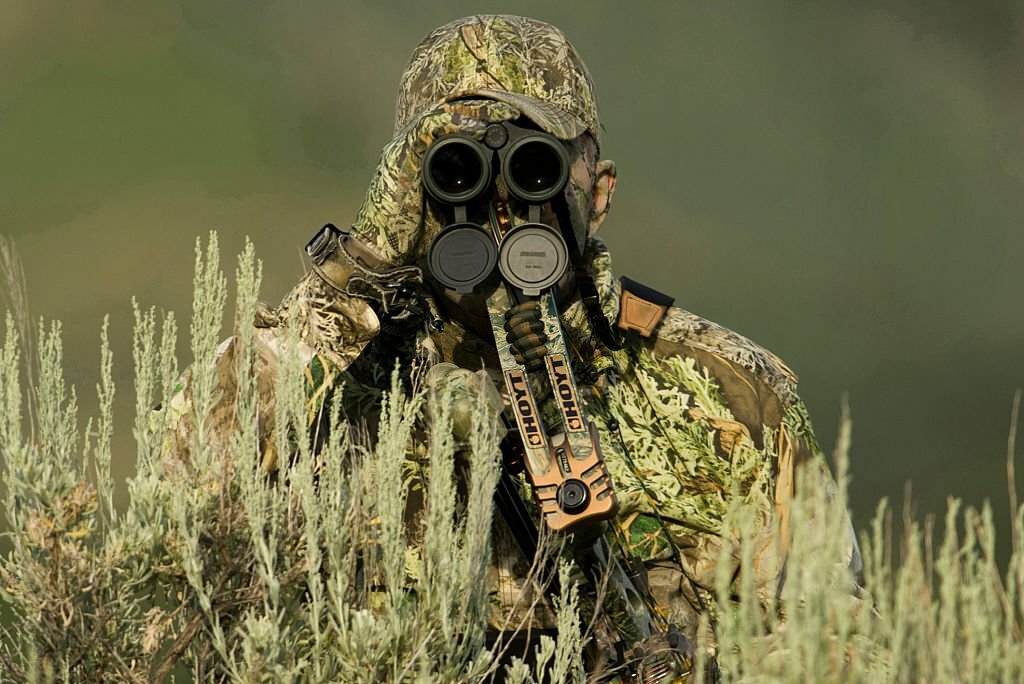
The Purpose of Camouflage for Hunting
It goes without saying that camouflage is a tactic employed for hiding to assist one in blending in with their environment.
Hunters are aware that being noticed can still occur even with the best camouflage pattern, but we’ll discuss it in another blog post. But it’s crucial to understand that, despite what many hunters may easily overlook, camouflage does contribute significantly to a hunt’s success.
A new generation of choices is attracting people’s attention, challenging traditional hunting camouflage designs. Consider the many patterns listed below, together with their advantages and disadvantages, before depending on your outdated equipment. You’ll be shocked by a couple of things, we bet!
Things to Consider When Buying the Best Camo for Deer Hunting
Intended Use
Before you purchase any hunting camos, decide what you want to use it for. The best camouflage pattern and level of weatherproofing and insulation required for the material will depend on how, when, and where you intend to utilize the camo. While a lot of camo choices are good for layering systems, others are better suited as standalone pieces or outer shells.
The ideal camo pattern will also vary depending on the sort of hunting. For example, wearing a shadow grass design might help a waterfowl hunter stay more covert when waterfowl hunting (e.g duck hunting), whereas a turkey hunter might choose to wear 3D prints or timber patterns.
Design Type
The type of camo and its design vary depending on the hunting terrain and target animal. Blaze orange is useful because some species, including deer, are blind to certain hues, like orange. Conversely, turkeys are more likely to startle and may need a greater degree of concealment. In any event, the goal of camouflage isn’t always to blend in with the surroundings and appear undetectable to animals. It serves to conceal your body’s shape inside the hunting area.
The three most popular patterns of camouflage for hunting are 3D, breakdown, and imitation. There are other types in nature that are used for military applications or as options for leisure apparel designs.
- Mimicry. A pattern known as “mimicry camo” imitates or replicates the natural setting in which you are currently hunting. Therefore, the camo may resemble tree bark from a treestand, or it may resemble tall grasses in a grassland setting.
- Breakup. When we see the multicolored blobs of camo patterns on garments, one of the most iconic camo designs that comes to mind is Breakup. Simply said, a breakup camo’s objective is to shatter your human figure against the surrounding landscape.
- 3D camo. In order to improve your capacity to blend in with the environment, 3D camo is similar to imitation camo but adds a three-dimensional element by sewing leaves and other pieces of fabric to the exterior of the garment. Not nearly as ornate as a ghillie suit, this is comparable.
Abstract camo is another kind that you could come upon. Abstract camouflage is less of a practical hunting camouflage alternative and more of a design or fashion decision. Its pattern is a little like digital camouflage or breakdown, but it comes in several shapes that may be either manufactured or natural.
Types of Camouflage Patterns
Take a look at this list below summarizing the most popular, and well-known types of camouflage patterns:
1. “Sticks and Leaves” (Mimicry) Camo Patterns
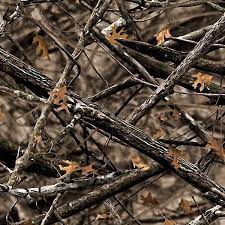
Since the “sticks and leaves” pattern is the signature design for some of the most well-known hunting camo brands, such as Realtree and Mossy Oak, it is recognizable to all hunters. Even if a lot of stock photos show off the greatest results these camo patterns may provide, it’s crucial to remember that they are only moments in time captured in a picture.
That mimicry-style camo might not be as appropriate for the surrounding area during the hunting season as conditions change and patterns and colors start to alter. Because of this, these camo designs may produce a silhouette that makes the surrounding game visible to you.
Best For:
The ideal candidates for this right camo pattern style are those who frequently hunt from a tree stand and who stay mostly still while the game is around. Although this pattern provides a fair level of concealment, it is not infallible in spot-and-stalk situations or when the terrain and circumstances start to change.
2. Large Contrast / Abstract Camo Patterns
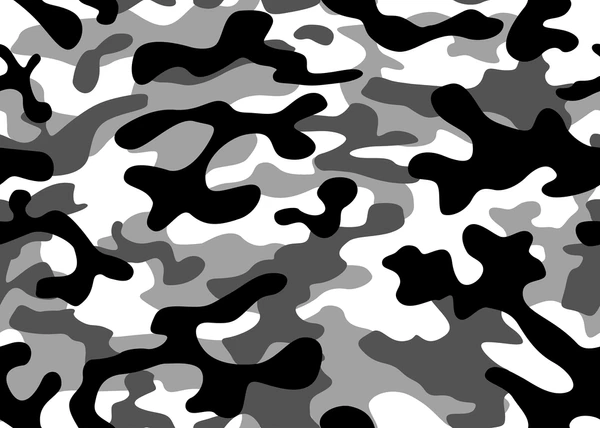
Hunters have been using the mimicry-style camou patterns mentioned above for many years. Nonetheless, a number of recent apparel producers are using contrast or abstract camo designs.
In order to address the silhouette issue, these specific different camo patterns adopt a more military-style approach to camouflage, combining abstract lines and forms with complementary colors. Check this Sitka image for a better understanding of how this operates.
The best camo pattern is one that breaks up your shape and aids in hunters’ ability to stay hidden against shifting terrain at various distance markers.
Best For:
Spot-and-stalk hunters and those seeking maximum cover when hunting from both short- and long ranges would benefit most from this camo pattern.
3. Traditional Camo Patterns
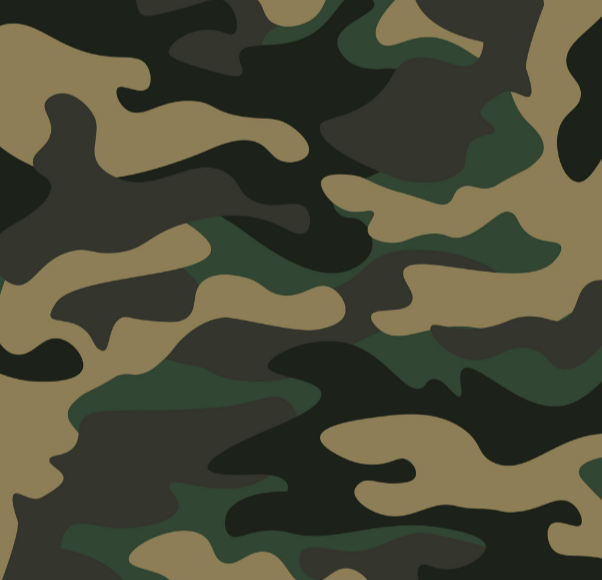
The hunting community immediately embraced the “frog” design, which gained popularity in the 1950s and is today regarded as a more “traditional” kind of camouflage.
Unfortunately, the U.S. military rapidly abandoned this kind of design, making it rather out of date. our is a really attractive and nostalgic-looking hunting pattern, but it doesn’t give the same high level of concealment as the other alternatives on our list.
Best For:
Only those who need the least degree of camouflage should choose this specific camo design, which provides the least amount of hiding. Traditional camou patterns are best suited for rifle hunters who stay far away from their game and don’t need much protection.
4. 3D Camo Patterns
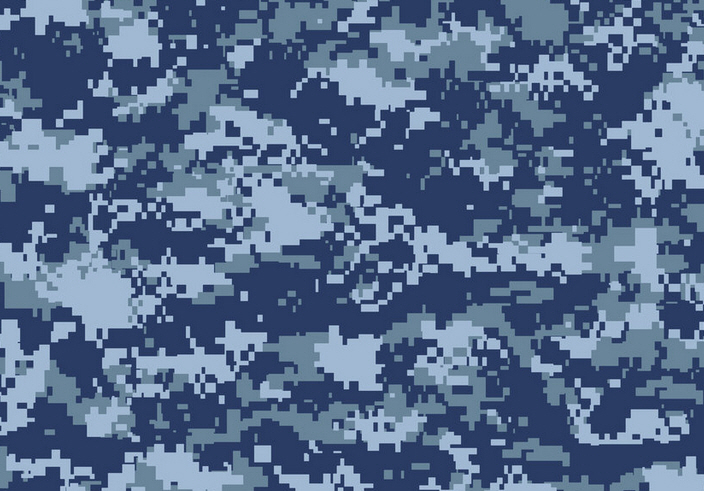
Today’s hunters don’t utilize 3D camo designs very often since they are a highly specialized kind of pattern.
Manufacturers have transitioned to a more lightweight “3D Leafy” type design for their conventional ghillie suits, which come with field grass and synthetic thread mesh shells.
Both of these make great cover under certain circumstances, but hunting in them is exceedingly challenging. The suite is heavy and made of extra material, which makes it difficult to move around and uncomfortable to wear in warm weather.
Best For:
The ideal candidates for this kind of camo pattern are those who hunt in the same kinds of terrain and weather conditions on a regular basis. Building or purchasing a high-performing 3D system will necessitate some degree of customization to the surrounding surroundings; otherwise, your suit is essentially useless.
Basic Camo Patterns
The majority of camouflage designs and color schemes are created to blend seamlessly with their surroundings. The majority of hunting camouflage fits into one of these categories, despite the appearance that a fresh, cutting-edge design appears on the market every year:
Woodland
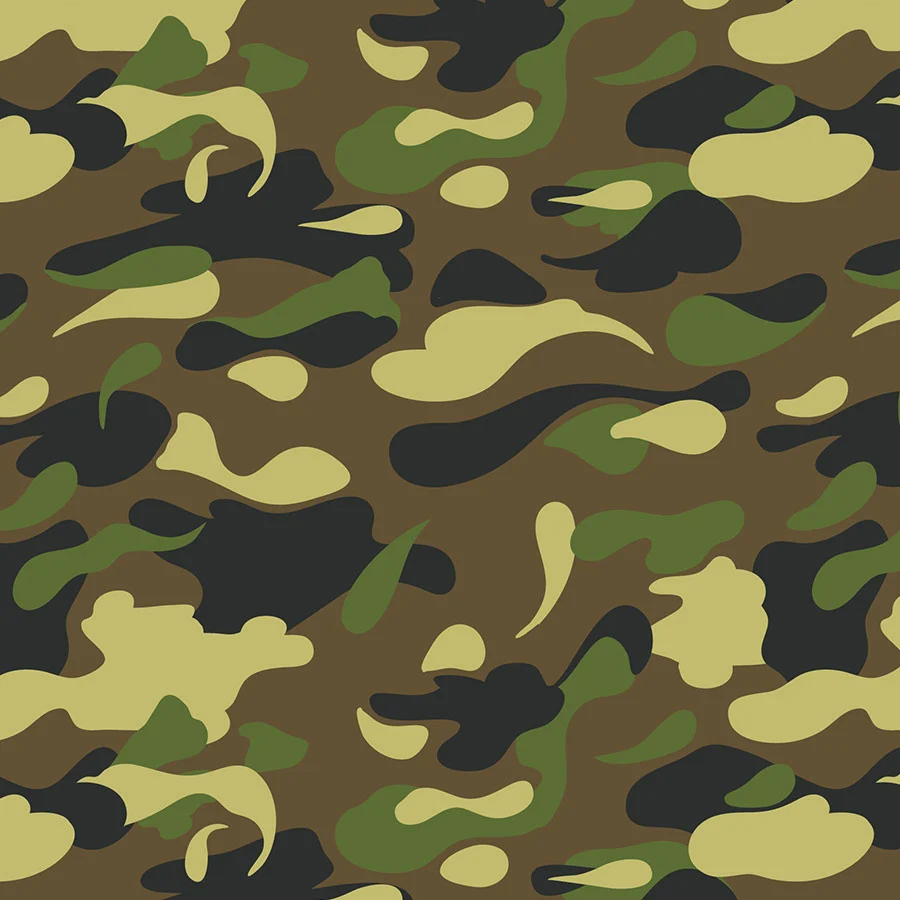
Marsh
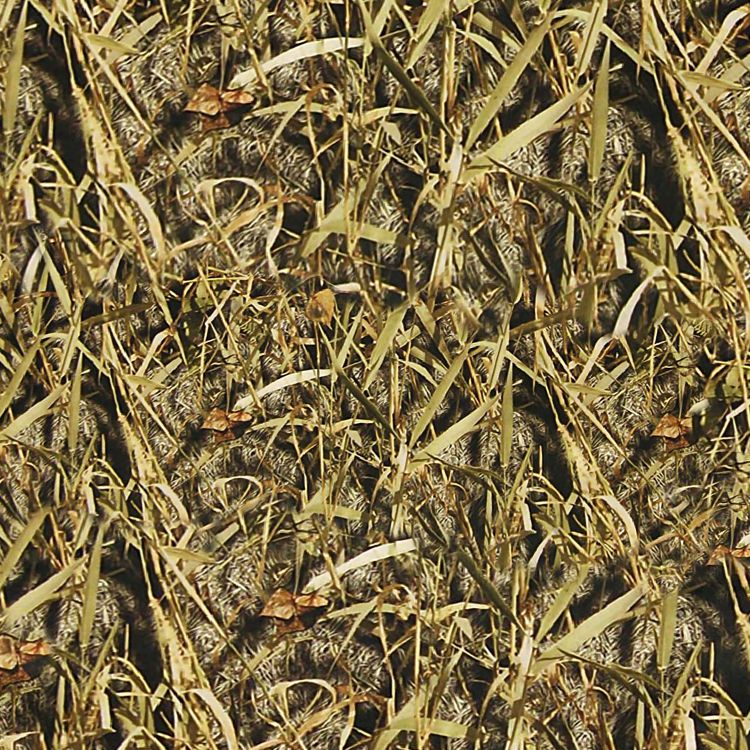
Brush
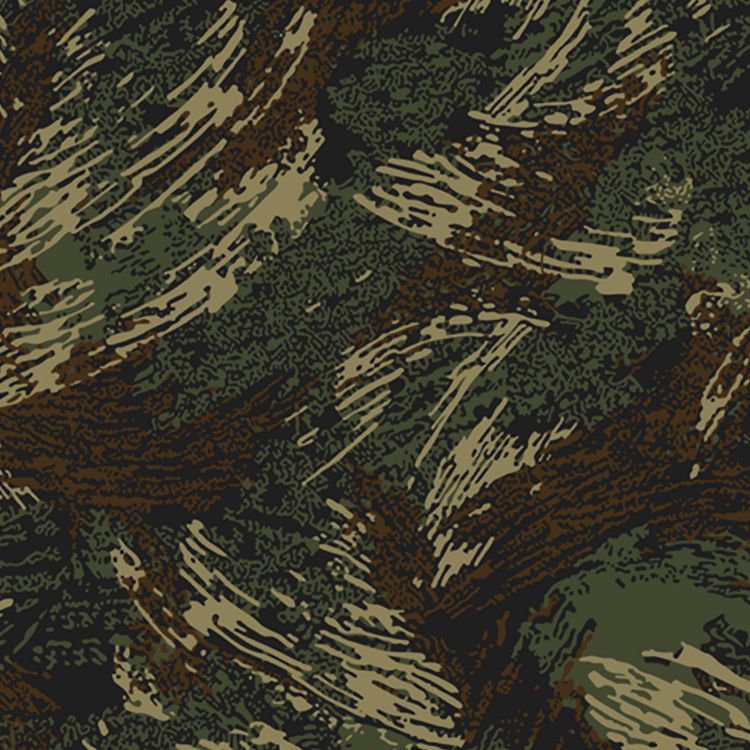
Snow
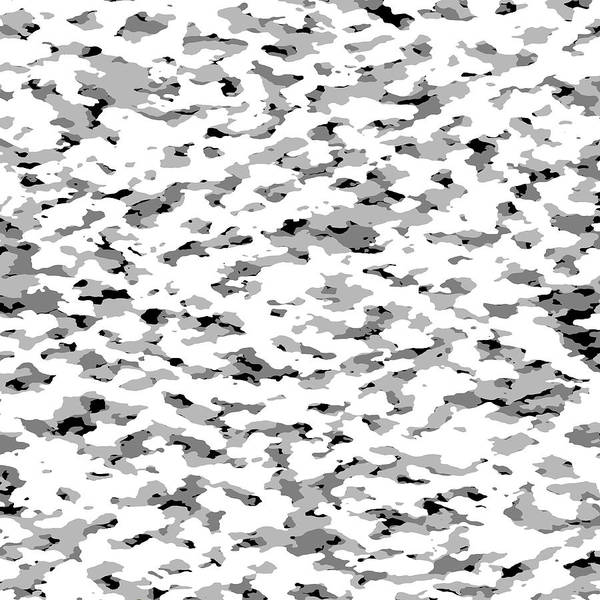
As you can see, densely forested places and woodlands are ideal for using woodland camo. With the exception of winter, when you should use a snow camo design if the weather permits, it is excellent for the majority of the deer hunting seasons. Marsh camo is mainly for waterfowl hunting and swampy areas, so it is not ideal for most deer or elk hunts. In the West, brush camo designs are ideal for elk hunting. Even in the absence of natural cover, you are kept hidden by the lighter patterns of dead grass and dirt, which blend in with the dry landscape.
Best Camo for Hunting: Reviews and Recommendations
1. Best Overall: Kuiu Verde Proximity Line
Key Features:
- Jacket Weight: 1 pound, 15 ounces
- Pants Weight: 2 pounds, 4 ounces
- 3DeFX+ insulation
- Brushed face outer fabric
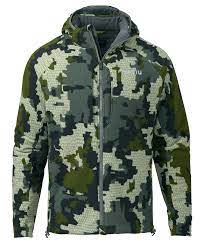
The Verde design by Kuiu is a touch darker and places greater focus on the contrast between the greys, greens, and blacks. Although it is intended for evergreen settings, we also discovered that hardwood settings are a great fit for it. Indeed, we used this high-contrast design to hunt during a few snowstorms this past season, and while wearing it, we managed to drop an unusual Michigan 9-pointer. Even at distances of up to ten yards, Michigan’s deer, which are known for being jittery, showed no signs of suspicion when we wore this camouflage.
Although the Proximity line’s brushed fabric was intended for use with treestands, we discovered that it functions just as well on the ground. When we went deer hunting in late November in almost total darkness, we wore Proximity, and it kept me nice and toasty. The material is not waterproof, despite being water-resistant. It will need to dry if it becomes wet. Regretfully, it does require some time. But you’ll struggle to find someplace quieter if you’re concerned about staying covert in the winter.
Pros:
- Very silent
- Warm and robust
- Very effective on close-range deer
Cons:
- Expensive
- Dries gradually
2. Best Insulated: Kuiu Valo Super Down
Key Features:
- Water-resistant Quixdown insulation
- Adjustable hood
- TORAY DWR water treatment
- Jacket Weight: 13.4 ounces
- Pants Weight: 16 ounces
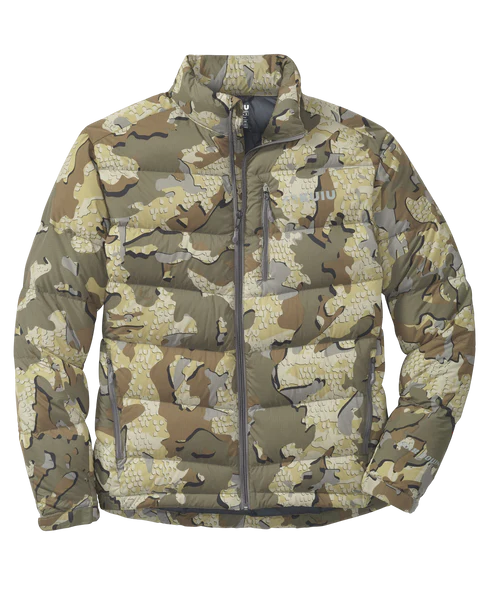
The Kuiu Valo pattern is a straightforward design that looks good in both the Midwest’s deer forests and the American West’s sagebrush. It features browns, tans, and greys. Here in Michigan, we’ve personally utilized the Kuiu Super Down, and we’ve discovered that it’s effective in deceiving whitetails’ eyes from both the ground and a treestand well into November. The Super Down series has excellent insulation for colder months.
You’ll be astounded by how light the jacket and pants are at the same moment. The jacket and pants keep you warm as the weather drops, which surprised us even though they are heavy. In fact, we discovered that, while utilizing the Super Down, we don’t need to layer up quite as much as we used to. In chilly weather, this keeps me much lighter on my feet. It is significant since it will result in less perspiration when entering the stand in the morning and less fragrance that may frighten deer.
The drawback is that it might be loud for bowhunting because the cloth sways somewhat while you move. For hunters who may hunt a range of terrain in several states over a season, this camo is our favorite choice. You’re prepared for everything Mother Nature throws at you if you match it with a decent pair of hunting gloves and a cap.
Pros:
- incredibly warm
- Not heavy
- Excellent in damp situations
Cons:
- Price
- Material is a bit noisy
3. Best Wind Resistant: Sitka Subalpine Jetstream
Key Features:
- Weight: 26 ounces
- Gore Windstopper fabric
- Fleece interior
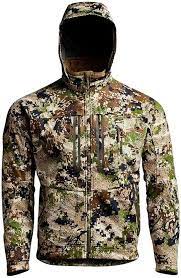
With a variety of bright greens, dark greys, browns, and tans, Sitka’s Subalpine pattern is made for spot-and-stalk type hunting in higher altitudes with verdant flora. In transitional areas when the amount of forest cover is decreasing, this camo also performs effectively. Sitka uses Gore-Tex Infinium, a windproof, breathable, and water-resistant material that is yet light and comfortable, to construct the Jetstream jacket, which is featured in Subalpine.
For the windier western areas like Wyoming and Montana, when the weather really picks up in September and October, we enjoy this jacket. The Jetstream jacket’s design isn’t ideal for the really cold temperatures that are sometimes seen later in the season. But Sitka has variations of this jacket for both men and women, so there’s something for everyone.
Pros:
- The greatest available wind protection
- Outstanding comfort
- Designed with spotting and stalking in mind
Cons:
- Expensive
- Not as good for more frigid conditions
4. Best Waterproof: First Lite Cipher Omen Stormshelter
Key Features:
- Jacket Weight: 26 ounces
- Pants Weight: 30.25 ounces
- 80/30 DWR repellent
- YKK zippers
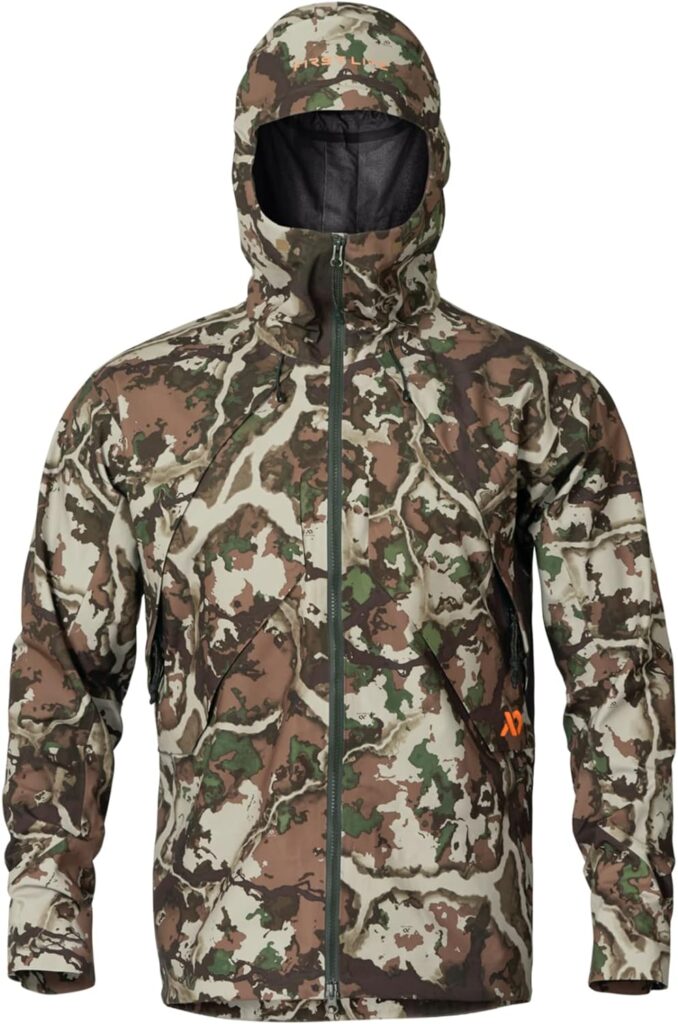
With a range of organic browns and tans, First Lite created their Cipher pattern to help you blend in with the sagebrush of the West and the fall foliage of the Midwest. Its simplicity is precisely what makes it so effective in breaking up your plan. For hunters who are constantly hunting in severely wet, snowy, and rainy weather, we suggest this jacket and pants set. An ideal setting for Pacific Northwest blacktail deer.
This is because the apparel is made more waterproof with the 80/30 DWR protection. The wide vents and the jacket’s chest cowl are what distinguish this from other camo rain gear. Being able to conceal a pricey rangefinder or binoculars under your rain gear is a good feature.
Pros:
- Layered to release a lot of water
- Premium-grade zippers
- Vented to let out surplus heat
Cons:
- The pants are a bit heavy
- Expensive
5. Best Budget: Realtree Edge Hunting Bomber Jacket
Key Features:
- 150 grams of insulation
- Drawstring hood
- Cotton ripstop fabric
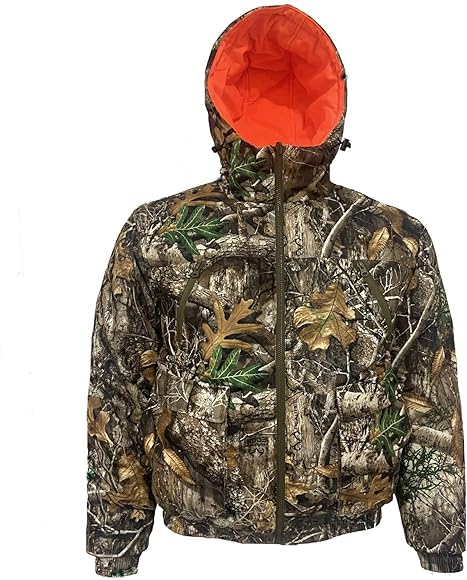
We have been Realtree supporters for many years, and we can vouch for the excellence of their products because both of my largest deer harvests occurred while wearing their designs. Edge is a traditional, less complex “sticks and leaves” camo for deer hunting. For most Midwestern hunting situations, this design will function. You can stay warm well into the season if you pair it with appropriate base layers.
For traditional hunters who do not want or desire the numerous pockets, bells, and whistles found in many contemporary hunting coats, the bomber jacket is a cost-effective alternative. For all kinds of hunters, it is also available in a large variety of sizes.
Pros:
- Affordable
- Bigger sizes available
- The Camo pattern is easy to match
Cons:
- Not the best at retaining cold heat
- Nicer cuffs would be wonderful.
6. Most Comfortable: Mossy Oak Bottomlands Hoodie
Key Features:
- Polyester/spandex blend
- Large front pocket
- Adjustable hood
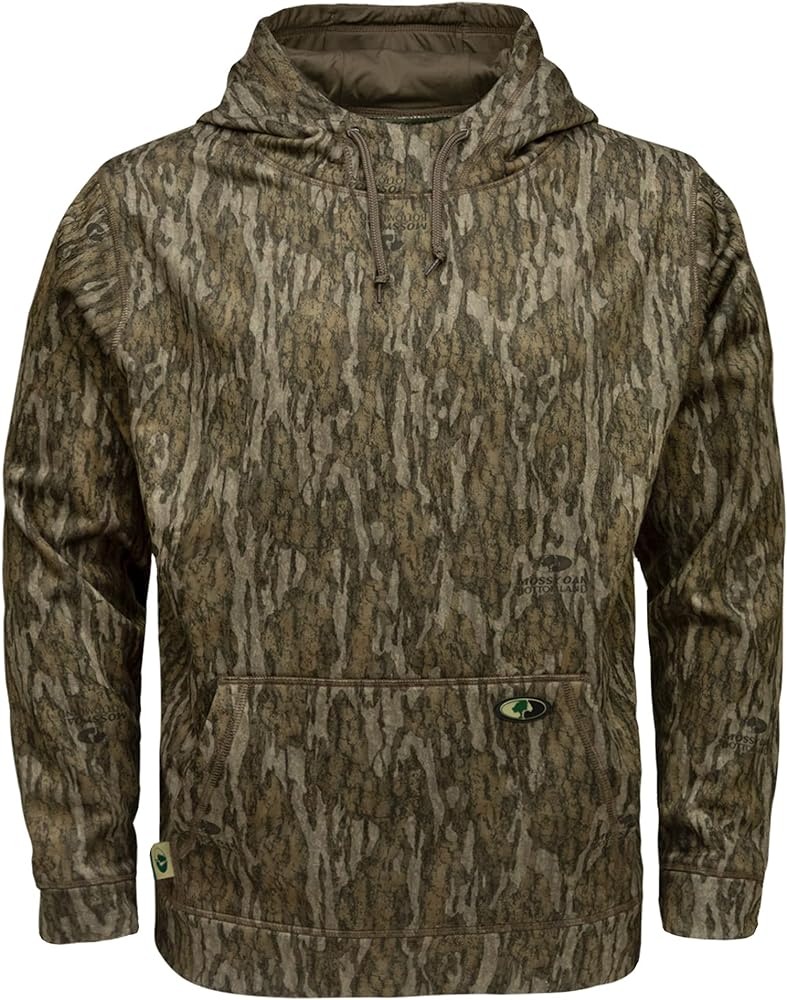
More deer harvests may have come from Mossy Oak Bottomland than from any other pattern now available on the market. For hardwood circumstances, especially in southern states like Georgia or Mississippi, we appreciate this traditional layout. Usually, you won’t need anything like this because the temperature down there is so pleasant. There are few things more comfortable than a hoodie, which is why it is our top choice for comfort. The drawback is that in the North, where the temperatures start to drop, it will not function as an outer layer. Despite this, it can be a good mid-layer choice.
This hoodie is quite reasonably priced at $45, so it may fit into almost any budget. For the larger guys looking to have a comfortable outdoor experience this season, Mossy Oak is offering this hoodie in sizes up to 3XL. Not to mention that on a cool day, it is excellent casual attire for working around the house or for fishing.
Pros:
- Quick and simple to clean
- Most comfy ever
- Suitable as a foundational layer
Cons:
- Mostly a southern or early-season option
7. Best for Odor Control: Scent Lok Divergent in Mossy Oak Terra Gila
Key Features:
- Carbon odor control tech
- Primaloft insulation
- Microfleece lining
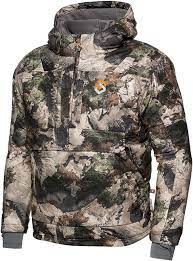
One of Mossy Oak’s most recent designs, Terra Gila, incorporates more of the open-concept deer hunting camos that are so fashionable these days. This design works just as well in thick forests as it does in open spaces. Furthermore, Scent Lok is the industry leader in odor management. They invented carbon technology, and many of the hunters we know are brand loyal.
It’s one thing to hide from a whitetail’s sight, but it’s as crucial to hide from their nose, and this camo accomplishes it better than any other product on the market. The expensive price tag is a drawback. The trousers and jacket cost $400 apiece, so most hunters may need to save up before adding them to their collection.
Pros
- Does a fantastic job of absorbing smells
- A safety harness port facilitates improved fit.
- The neck gaiter provides excellent defense.
Cons
- Expensive
How to Choose the Best Deer Hunting Camo
Although deer have poor color vision, it still depends on what kind of breakdown camo you use. Since deer are still able to recognize patterns, the backdrop of your camo must match the area where you intend to hunt. Regretfully, there isn’t a single camo design that fits perfectly in every setting. Depending on the hunting location and season, you should select a camo design for deer hunting. Even if it might be challenging to choose the ideal hunting camo design for whitetails, it can be beneficial to consider your hunting strategy.
For instance, you will be higher in the tree line if you are hunting in the north in a treestand. This implies that you have to disappear into the trees and sky. On the other side, if you’re on the ground, you’ll want a camo pattern that makes it easier for you to blend in with the dark tree bark and branches. Imagine the same circumstances inverted now. Deer will perceive a strange black patch in the tree line if you are wearing a darker hunting camo while in a treestand. Deer would perceive you as a light blob against the darker woods if you were wearing lighter hunting camo while on the ground. These patterns affect how quickly deer will perceive your movement regardless of color.
Choosing the best deer hunting camo involves considering various factors to ensure effective concealment in different environments. Here’s a guide to help you make an informed decision:
1. Consider Your Hunting Environment:
Wooded Areas: Opt for camo patterns with a mix of browns, greens, and grays to blend with trees and foliage.
Open Fields: Choose patterns with more muted tones and a combination of light and shadow for blending in with grass and shrubs.
2. Match the Season:
Early Season: Use patterns with more green to match the foliage during spring and early summer.
Mid-Season: Transition to patterns with a mix of green and brown as foliage changes.
Late Season: Choose patterns with browns and grays to match the bare trees and fallen leaves.
3. Pattern Size:
Consider the size of the camo pattern. Larger patterns may work better from a distance, while smaller, detailed patterns can be effective at close range.
4. Brand and Material:
Research reputable brands are known for quality camo. Consider materials that are quiet, breathable, and suitable for the weather conditions you’ll be hunting in.
5. Adaptability:
Choose a camo that works well in a variety of terrains. Some patterns are designed to be versatile and effective across different hunting environments.
6. Camouflage Accessories:
Complement your clothing with camo accessories like gloves, facemasks, and hats. These help break up your hunter’s outline and increase overall concealment.
7. Local Knowledge:
Consider local vegetation and color schemes. Camo patterns that mimic the specific flora in your hunting area can provide better concealment.
8. Scent Control:
While not directly related to camo patterns, consider incorporating scent control techniques. Deer have a keen sense of smell, and minimizing your scent can enhance your concealment.
9. Testing in the Field:
Before the hunting season, test your camo in the actual hunting environment. Assess its effectiveness by observing how well it blends into the surroundings.
10. Budget:
Set a budget for your hunting gear, including camo. While high-end options exist, there are also quality, budget-friendly camo choices available.
Remember that the effectiveness of deer hunting camo is not just about the pattern but also about how you use cover, movement, and wind direction to your advantage. No single camo pattern works perfectly in all situations, so choose based on the specific conditions you’ll encounter during your hunting adventures.
Best Hunting Camo Patterns By Region
Choosing the best hunting camo patterns by region and terrain can significantly improve your concealment in the field. Here are recommendations for each region and an all-terrain, all-season option:
The East:
- Wooded Areas:
- Recommended Camo: Mossy Oak Break-Up Country, RealTree Xtra Green.
- Why: These patterns incorporate a mix of browns, greens, and shadows, blending well with the dense foliage common in eastern wooded areas.
The North/Midwest:
- Open Fields and Mixed Terrain:
- Recommended Camo: Sitka Optifade Open Country, First Lite Fusion.
- Why: These patterns offer a combination of light and shadow, mimicking the varied terrain found in the North and Midwest, including open fields and transitional zones.
The South:
- Thick Brush and Swampy Areas:
- Recommended Camo: Realtree Max-5, Mossy Oak Bottomland.
- Why: These patterns feature earthy tones and shadows, ideal for blending with thick brush and the swampy environments common in the southern regions.
The West:
- Mountainous and Arid Terrain:
- Recommended Camo: Kryptek Altitude, Sitka Optifade Subalpine.
- Why: These patterns incorporate grays and lighter tones, suitable for mountainous and arid landscapes often found in western regions.
All Terrain- All Season:
- Versatile Camo for Various Environments:
- Recommended Camo: Gore Optifade Concealment.
- Why: Designed for adaptability, Optifade patterns consider the way ungulates (like deer) perceive color. This makes them suitable for various terrains and seasons.
Remember, while these recommendations offer a starting point, individual preferences, and local vegetation should also influence your choice. Additionally, consider the season-specific coloration within each brand’s line, as many offer variations tailored to different times of the year. Always test your camo in the specific environment you’ll be hunting to ensure optimal concealment.
Best Hunting Camo Patterns for Deer and Other Big Game Hunting
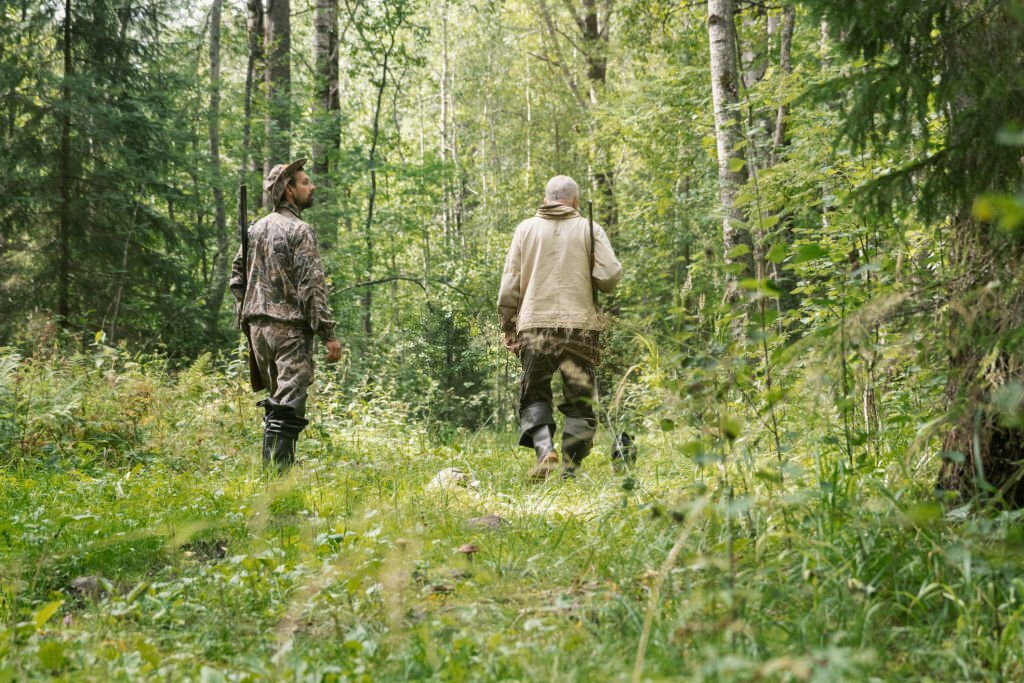
Large game hunters understand the value of hunting camo in terms of concealment. With the correct pattern, you may virtually disappear from your target, allowing you to come up close and grab the greatest shot. It might be difficult to choose which hunting camo design will help you collect the most meat this season because there are so many variations available. We’ll break down several hunting camo patterns in this tutorial so you can choose the finest bow-hunting and deer-hunting camo for your situation and the animal you’re pursuing.
Types of Hunting Camo
Let’s review some of the fundamentals of camouflage before talking about the finest camo for large game and deer hunting. Regardless of the name given to it by well-known companies like Realtree and Mossy Oak, all hunting camouflage patterns belong to one of two categories: mimicry and disintegration (digital camo).
What Is Mimicry Camo?
Mimicry camo, as the name implies, attempts to blend in with your surroundings. For autumn hunts, this may have a brown backdrop with branches and sticks, while for winter, it could have a white background with branches and sticks. Consider it as the kind of camouflage that, in the proper hands, could trick a human. On a hunt, though, wearing imitation camo correctly can be difficult because of shifting seasons, unpredictable weather, and unanticipated changes in the hunting area.
What Is Breakup Camo?
Digital camouflage, or breakup camouflage, breaks up your outline to make you look more natural. Breakup camo uses colors and forms to accomplish camouflage, as opposed to imitation camo, which incorporates real parts of nature into the design. In a test, this camouflage should be significantly easier for humans to discern than mimicking. But keep in mind that you’re hiding from the animal you’re hunting and that animals—especially large game—do not view the environment the same way that humans do.
Do I Need Camo for Hunting Deer and Other Big Game?
Wearing camouflage hunting apparel enables you to approach your target up close for a clearer, more accurate shot. You would have to shoot from a farther distance if you didn’t have the appropriate camo to hide from detection. Although it is possible to look good in your regular clothes, it is strongly advised. A shot is more morally acceptable the closer it is to your target. With a long-range rifle, seasoned hunters might be able to get by without camouflage, but bowhunters will always require concealment in order to approach their prey.
It’s also important to keep in mind that most states mandate that you hunt in blaze orange camo. Before you go on your next hunt, be sure to review the applicable state and municipal restrictions. If you’re worried that the vivid orange hue will reveal where you are, keep reading to find out why big game hunting doesn’t care about that.
How to Choose the Best Bow Hunting Camo
The distance between you and your target is the primary distinction between bow and rifle hunting. To efficiently take down their target, bow hunters must approach it from a close distance—typically no more than 20 yards. In all honesty, there isn’t much of a difference between the camouflage used for rifle and bow hunting. The preceding thinking patterns will help your bowhunting camouflage to function flawlessly.
Your choice of camo is far less important while bowhunting than your noise and scent. The sense of smell is a deer’s most powerful protection mechanism. You can use traditional smell blockers or hunting garments with odor control built in, such as those made by ScentLok.
When it comes to noise reduction, be sure to get hunting trousers that are described as silent or quiet in the features or description. Popular manufacturers like Browning, TrueTimber, and others provide a broad range of quiet hunting pants that significantly lessen the noise produced when moving. They also come in a number of hunting camo styles.
Hiding in Plain Sight
Big game hunting camo comes in a variety of patterns and styles to keep you undetectable. Even though there are so many camouflage patterns available, some careful consideration exercises can help you identify the ideal hunting camouflage for your requirements. Here’s a brief summary of the topics we discussed today:
- The finest concealment for deer hunting is break up.
- Brown trees and bright orange jackets are indistinguishable from deer.
- In order to blend in with the skyline and treetops, treestand hunters typically wear a different camo than spot-and-stalk hunters.
- As long as it makes sense, you can mix and match different camo designs on your hunting attire.
- While bowhunting and camouflage are highly advised, it’s crucial to keep your smell and noise under control.
Final Words
In conclusion, choosing the best hunting camo pattern involves considering factors such as your hunting region, terrain, and the specific conditions you’ll encounter. Remember these final thoughts for selecting effective camo:
Adaptability is Key:
Choose camo patterns that are versatile and adaptable to different terrains and seasons. This ensures you’re prepared for various hunting environments.
Local Considerations:
Take into account the specific vegetation and color schemes of your local hunting area. Matching your camo to the surroundings enhances your concealment.
Test Before Use:
Before the hunting season begins, test your camo in the actual hunting environment. This allows you to assess its effectiveness and make adjustments if needed.
Layering and Accessories:
Consider layering your camo for versatility in changing weather conditions. Accessories like gloves, facemasks, and hats further break up your silhouette.
Scent Control:
While not directly related to camo patterns, integrating scent control techniques is crucial. Minimizing your scent enhances overall concealment, especially when hunting deer with a keen sense of smell.
Individual Preferences:
Camo’s choice can be somewhat subjective. Personal preferences, comfort, and the way the camo pattern makes you feel in the field are essential factors.
Quality Matters:
Invest in quality camo from reputable brands. Quality materials ensure durability, comfort, and functionality during your hunts.
Stay Informed:
Keep abreast of new developments in hunting camo technology. Manufacturers often introduce innovations in pattern designs and materials that can improve your overall hunting experience.
Ultimately, the best hunting camo pattern is the one that aligns with your hunting environment, provides effective concealment, and enhances your overall hunting experience. Take the time to research, test, and choose a camo that suits your specific needs and preferences for a successful and enjoyable hunting season.
FAQs
1. Does camo really help with hunting?
The camouflage colors don’t do much good because most animals can’t detect color, but the patterns assist in contrasting your silhouette with the surrounding landscape. The kind of hunting and the environment affect how effective the camo is. For instance, it isn’t as crucial for bowhunting or any other type of predator hunting as it is for upland bird hunting.
2, What are the 4 types of camouflage?
The four primary forms of camouflage that people use are imitation, breakdown, 3D, and abstract, while there are many more varieties seen in nature. Every type of camo has different uses as well as advantages and disadvantages.
3. Is black good for camouflage?
Although it may be used for concealment, black is most frequently utilized as a pattern element. Your camouflage is meant to be stealthy at night if it is entirely black.
4. Can Deer See Blaze Orange Hunting Vests?
Deer are often less sensitive to long wavelength hues, such as orange and red. They are probably going to notice hues like blue or green that are short and medium wavelengths. Deer are not able to detect blazing orange because, to humans, they are effectively red-green color blind. Although it may be used for concealment, black is most frequently utilized as a pattern element. Your camouflage is meant to be stealthy at night if it is entirely black.
5. Can You Mix and Match the Camo Pattern?
The aforementioned point is an excellent illustration of how, in the appropriate situation, mixing and matching camo may work. This is a search, not a fashion display. To maximize your chances of stocking your freezer with fresh meat, wear clothes that fit properly. Treestand hunters could choose darker forest hunting pants to go with the tree they’re sitting in, but a snow or lighter woodland camo hunting jacket to match the skyline.
For winter hunts, spot-and-stalk hunters might choose to wear a forest shirt and snow camo leggings to match the bare tree bark behind them and the ground. Don’t be scared to choose a camo that deviates from the norm.
6. Is military camo better than hunting camo?
While both hunting and military camouflage are suitable for their respective uses, they cannot be used interchangeably. Having a hunting camo is a preferable concealing choice, even though military camo could be effective in some hunting scenarios. Military camo is, in a way, made to accommodate a wider range of human emotions. On the other hand, hunting camo is more effective for hunting since it is usually tailored for a particular area or activity.
